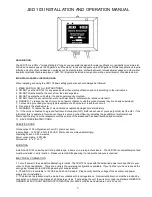
AUDIO KONTROL 1 – 63
In this case, we will use KORE PLAYER, included in the AUDIO KONTROL 1
bundle. As mentioned earlier in this manual, a Factory Page for KORE PLAYER is
readily available.
Most importantly, KORE PLAYER needs to be connected to both the MIDI input
ports that AUDIO KONTROL 1 provides. Note that only one of them is actually
present within the hardware. The other port is only virtual, which is indicated by
its name “Audio Kontrol 1 VirtualIn”. It is used to establish a connection between
the Mapping Application and the target application to be controlled remotely, in
this case KORE PLAYER. We already explained how to setup this MIDI connec-
tion inside KORE PLAYER in the first quickstart. Refer to that section (5.1) or to
the KORE PLAYER manual to find information on how to configure its MIDI input
ports. Because we won’t be repeating all the details every time, we recommend
that you read the previous Use Case and the former quickstarts to get used to the
terminology (Layers, tabs, etc.). In any case, you will find all relevant information
in the Reference section.
6.3.1. Factory Page Overview
Loading a Factory Page
Let’s look at these Pages. If it isn’t already running, start KORE PLAYER.
Bring the
Mapping Application
to the front, open the
Page Select
menu by clicking on
it, and select the Page “NI Kore Player”. The Factory Page now loads. On this Page,
two
Buttons
are set up as switches, while the Right Button works as a
modifier
, i.e. it
modifies the other controllers’ behavior when it is pressed and held (like the Shift
key on your computer keyboard).
For example, here is what the Controller Knob does:
With no Button pressed, it moves the Sound Variation Morph horizontally across
the Sound Variation Grid, starting at Sound Variation 1 in the top left corner
of the Grid.
►
















































